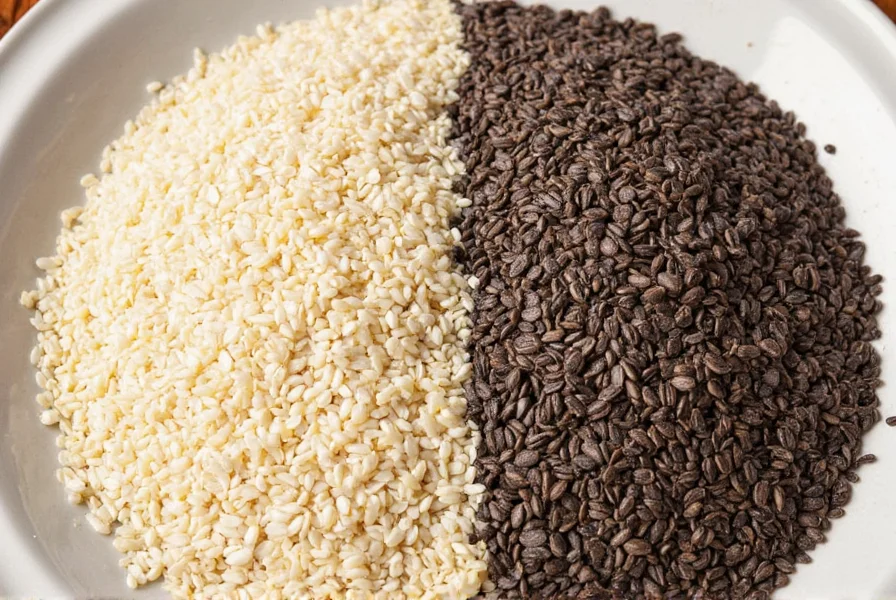Introduction
White and black sesame seeds differ significantly in processing, flavor, nutrition, and culinary uses. White sesame seeds are hulled (outer shell removed), resulting in a milder taste and softer texture, while black sesame seeds are typically unhulled, offering a stronger, earthier flavor and higher nutritional content. This guide breaks down the key differences to help you choose the right type for your cooking needs.
| Feature | White Sesame Seeds | Black Sesame Seeds |
|---|---|---|
| Hull | Hulled | Unhulled |
| Flavor | Mild, nutty, slightly sweet | Bold, earthy, faintly bitter |
| Texture | Softer, easier to chew | Firmer, crunchier |
| Appearance | Pale beige to off-white | Deep black to charcoal |
| Cooking Use | Baking, coating, dressings | Desserts, stir-fries, medicinal use |
| Nutrition | Good for magnesium, iron | Richer in fiber, calcium, antioxidants |
Cooking Tips & Tricks with Sesame Seeds
Whether you're a seasoned chef or just starting out, here are some pro tips to make the most of your sesame seed stash:
- Toasted or Raw? Toasting enhances the nuttiness. Simply heat them in a dry skillet over medium heat until fragrant — about 3–5 minutes.
- Use Whole or Ground? Grinding brings out oils and intensifies flavor. Try making your own sesame butter or paste!
- Pairing Suggestions:
- White: Honey, soy sauce, coconut, lemon
- Black: Chocolate, vanilla, rice wine vinegar, ginger
- Storage Tip: Store in an airtight container in a cool, dark place. For longer shelf life, keep them refrigerated or frozen.

Buying Guide: Choosing the Right Sesame Seeds
Not all sesame seeds are created equal. Here's how to pick the best ones for your culinary adventures:
1. Whole Seeds vs. Hulled
- Whole Seeds: Ideal for high-fiber diets; often black or brown. Great for traditional dishes and raw uses.
- Hulled Seeds: Softer texture and milder flavor. Best for baking and blending.
2. Organic vs. Conventional
- Organic options avoid pesticides and chemicals. If you eat them regularly, organic might be worth the splurge.
3. Roasted vs. Raw
- Roasted seeds offer deeper flavor but less versatility. Raw seeds can be toasted at home for maximum freshness.
4. Brand Recommendations
Here are a few popular brands that offer quality products:

NOW Foods Organic White Sesame Seeds
- Features: USDA certified organic, raw and hulled
- Advantages: Mild flavor, perfect for baking and sauces
- Target Audience: Health-conscious bakers and general cooks
- Best For: Tahini, dressings, and baked goods

Bermuda Black Sesame Seeds
- Features: Unhulled, rich in calcium and fiber
- Advantages: Strong aroma and bold flavor profile
- Target Audience: Dessert lovers and Asian cuisine enthusiasts
- Best For: Ice cream bases, traditional sweets, stir-fries

Eden Foods Natural Sesame Seeds
- Features: Non-GMO, kosher-certified, roasted
- Advantages: Ready-to-use with a rich, toasted flavor
- Target Audience: Quick meal prep fans and busy cooks
- Best For: Toppings, garnishes, quick snacks

Frequently Asked Questions
Here are answers to the most common questions about white and black sesame seeds:
What is the main difference between white and black sesame seeds?
The primary difference lies in processing and nutritional content. White sesame seeds are hulled (outer shell removed), resulting in a milder flavor and softer texture. Black sesame seeds are typically unhulled, giving them a bolder, earthier taste, firmer crunch, and higher fiber, calcium, and antioxidant levels due to the retained hull.
Can I substitute black sesame seeds for white in recipes?
Yes, but with flavor and appearance considerations. Black sesame seeds will add a stronger, slightly bitter note and dark speckles to dishes. They work well in robust recipes like stir-fries or desserts, but may overpower delicate baked goods where white seeds' mild flavor is preferred.
Which type is more nutritious?
Black sesame seeds generally offer greater nutritional density due to the unhulled nature. They contain significantly more fiber and calcium, plus higher levels of antioxidants like polyphenols. White seeds still provide healthy fats and B vitamins, but the hull removal reduces some nutrient content.
How long do sesame seeds last?
Stored properly in an airtight container away from light, raw sesame seeds last 6-12 months at room temperature. For extended freshness, refrigerate (1-2 years) or freeze (2+ years). Toasted seeds have a shorter shelf life due to released oils—use within 3-6 months.
Are black sesame seeds safe for daily consumption?
Yes, black sesame seeds are safe for regular consumption in culinary amounts. Their high fiber content may cause digestive discomfort if introduced suddenly in large quantities—start with 1-2 teaspoons daily. Those with sesame allergies should avoid both types entirely.











 浙公网安备
33010002000092号
浙公网安备
33010002000092号 浙B2-20120091-4
浙B2-20120091-4